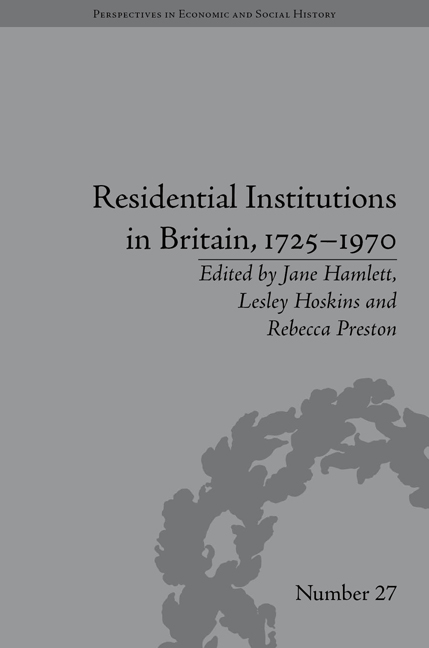Book contents
- Frontmatter
- Contents
- Acknowledgements
- List of Contributors
- List of Figures
- Introduction
- 1 Viewing the Early Twentieth-Century Institutional Interior through the Pages of Living London
- 2 ‘French Beef was Better than Hampstead Beef’: Taste, Treatment and Pauperism in a London Smallpox Hospital, 1871
- 3 From Asylum to Mental Hospital: Gender, Space and the Patient Experience in London County Council Asylums, 1890–1910
- 4 Refuge or Prison? Girls' Experiences of a Home for the ‘Mentally Defective’ in Scotland, 1906–1948
- 5 Paupers and their Experience of a London Workhouse: St Martin-in-the-Fields, 1725–1824
- 6 ‘A Veritable Palace for the Hard-Working Labourer?’ Space, Material Culture and Inmate Experience in London's Rowton Houses, 1892–1918
- 7 ‘The Place was a Home from Home’: Identity and Belonging in the English Cottage Home for Convalescing Psychiatric Patients, 1910–1939
- 8 ‘The Father and Mother of the Place’: Inhabiting London's Public Libraries, 1885–1940
- 9 ‘Discipline with Home-Like Conditions’: The Living Quarters and Daily Life of the Women's Army Auxiliary Corps in First-World-War Britain and France
- 10 Halls of Residence at Britain's Civic Universities, 1870–1970
- Notes
- Index
3 - From Asylum to Mental Hospital: Gender, Space and the Patient Experience in London County Council Asylums, 1890–1910
- Frontmatter
- Contents
- Acknowledgements
- List of Contributors
- List of Figures
- Introduction
- 1 Viewing the Early Twentieth-Century Institutional Interior through the Pages of Living London
- 2 ‘French Beef was Better than Hampstead Beef’: Taste, Treatment and Pauperism in a London Smallpox Hospital, 1871
- 3 From Asylum to Mental Hospital: Gender, Space and the Patient Experience in London County Council Asylums, 1890–1910
- 4 Refuge or Prison? Girls' Experiences of a Home for the ‘Mentally Defective’ in Scotland, 1906–1948
- 5 Paupers and their Experience of a London Workhouse: St Martin-in-the-Fields, 1725–1824
- 6 ‘A Veritable Palace for the Hard-Working Labourer?’ Space, Material Culture and Inmate Experience in London's Rowton Houses, 1892–1918
- 7 ‘The Place was a Home from Home’: Identity and Belonging in the English Cottage Home for Convalescing Psychiatric Patients, 1910–1939
- 8 ‘The Father and Mother of the Place’: Inhabiting London's Public Libraries, 1885–1940
- 9 ‘Discipline with Home-Like Conditions’: The Living Quarters and Daily Life of the Women's Army Auxiliary Corps in First-World-War Britain and France
- 10 Halls of Residence at Britain's Civic Universities, 1870–1970
- Notes
- Index
Summary
‘The Modern Asylum has Long Passed the Prison Workhouse Stage, and its Work Demands Recognition as a Mental Hospital in Every Sense of the Word’
In February 1901, the eminent asylum architect George T. Hine presented a lengthy paper titled ‘Asylums and Asylum Planning’ to the Royal Institute of British Architects. Asylum construction was, he contended, ‘a special branch of architecture’ because ‘asylums are built for people who cannot take care of themselves, and who have to be watched, nursed, and provided with employment and recreation under conditions inapplicable to sane people’. He cited plans for the East Sussex Asylum when outlining his vision for a new type of public asylum which, in this case, included an acute hospital for eighty patients that would be nearly half a mile from the main asylum building (itself holding 840 patients of all classes); four detached villas containing thirty patients each; and ‘a block for sixty idiot and imbecile children’. This indicated a distinct move towards an approach that was ostensibly more patient-centric, away from the old style of building, which accommodated patients according to the institutional resources required to manage them (for example, more attendants worked on refractory wards for disturbed patients than on those for ‘quiet and chronic’ patients). Previously, patients admitted for disorders that were believed to be curable might live beside those who had chronic and congenital conditions.
- Type
- Chapter
- Information
- Residential Institutions in Britain, 1725–1970Inmates and Environments, pp. 51 - 64Publisher: Pickering & ChattoFirst published in: 2014

